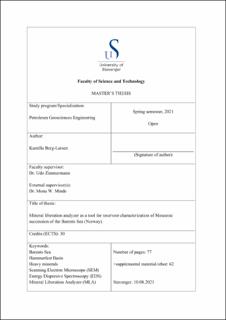| dc.description.abstract | Heavy mineral studies have been applied to a selection of samples from the Kolmule Formation from the Cretaceous age and from the Stø Formation of Jurassic age to understand the rock composition of the samples and develop further interpretations. The employed methods give the opportunity to study the single-grain analyses, which gives a more complete insights into the formation and history of the sediment and its detrital composition. It enables the opportunity to study the grain size, shape, sorting and distribution of both particle size and density. Based on results from different analytical methods, Scanning Electron Microscope (SEM), Energy Dispersive Spectroscopy (EDS) and Mineral Liberation Analyzer (MLA) the heavy minerals are identified. The heavy minerals that are identified and present in all the samples are tourmaline, biotite, apatite, zircon, garnet, barite, ilmenite, sphalerite, rutile, galena pyrite and chromite. Within the samples it was possible to see a wide variation of grain sizes for both formations. Both formations was also moderately to poorly sorted, indicating that either the source have been rather close and/or sediment transport was relatively quick without major processes to sort the detritus, which can indicate fluvial deposits or those related to very steep slope gradients and short transport distances. The Kolmule Formation have larger amounts of tourmaline, rutile and garnet present in the samples, indicating dominantly metamorphic sources. The sorting combined with the most abundant heavy minerals, points to a direct recycled source dominated by mainly felsic and mafic metamorphic debris. The Stø Formation have large amounts of zircon, pyrite, rutile, tourmaline and garnet present in the samples, indicating a rather felsic sources, with felsic fingerprints, recycled and mainly of metamorphic origin. Stø Formation has larger grains, indicating that this formation has been transported over a smaller distance than the Kolmule Formation and with a higher energy. ZTR-index for Stø Formation is rather higher than for Kolmule Formation, meaning that the source of Stø is more reworked compared to the Kolmule Formation, this indicates again that it is not possible that Kolmule Formation has been derived from the Stø Formation. Based on these information it can be speculated that the sources for both are composed of mainly Caledonian detritus, which mostly is of metasedimentary nature and contains less igneous material.
The project showed very well, especially caused by Covid-19 restrictions, that SEM-EDS studies are informative but cannot match MLA analyses. The latter are more insightful in regard of grain size and forms and reflect a much more complete composition of the rocks.
Moreover, the study showed that so-called “combined” sampling (combining several grain sizes and facies to characterize a formation) reflects the same composition as three samples from specific horizons of a formation, but abundances of the most often occurring heavy minerals differ. Especially garnet seems to be an issue when studying with SEM-EDS. However, this needs more intensive and detailed studies in the future. | |
